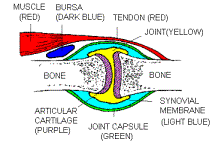Materials to help Arthritis
B. Maddox
One of the biggest challenges facing current materials engineers is how to imitate or reproduce materials found in the body. As peoples life span increases, their bodily materials, such as bone, cartilage, blood vessels, and skin start to weaken.
Cartilage is a slippery, soft, yet strong material that cushions and lubricates your joints. As you age, this cartilage can start to break down, causing the bones in your joints to knock together and become stiff. This condition is known as arthritis.

Materials engineers are helping in the fight against arthritis by researching new materials to replace cartilage that has broken down. One new material for this purpose is called Salubria. It's name is derived from Latin words meaning safe and healthy.
Salubria is known as a hydrogel, because it is composed of an organic polymer and water. It's strength and viscosity can be manipulated by changing the degree of cross-linking in the polymer and the amount of water in the gel.
Salubria has not yet been tested in humans but it has shown high biocompatiblity in rats, dogs, and sheep. When designing biomaterial it is important that nothing in the material will react badly with the body. Silicon for example, is known to cause inflammation. Other materials such as mercury and lead must be avoided due to toxicity concerns.
When Salubria is implanted into the body it acts like a shock absorber or water bag between bones in patients with arthritis or sports injuries to the knee.
Other alternatives for replacing the cartilage lost in the knee due to arthritis or injury is a Unispacer. This metallic kidney shaped implant has a low coefficient of friction to allow the knee to glide and is strong enough to support the load of the body during high impact activities while absorbing shock.
The design of polymers and metals for use in the body is a project that will occupy materials engineers (as well as chemical and mechanical engineers) for many years.
